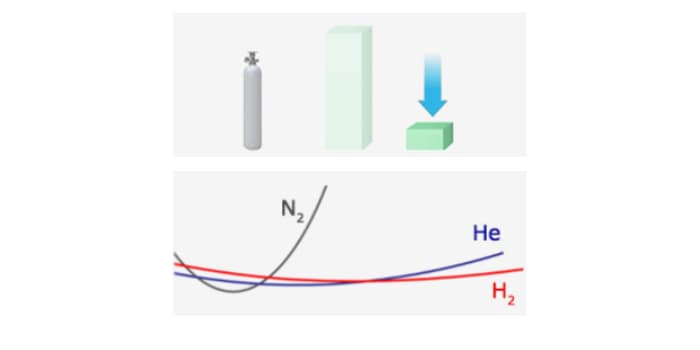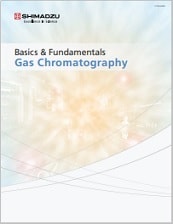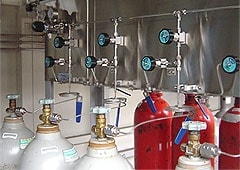Gas Chromatography
Gas Chromatography
Since our first Gas Chromatograph (GC) was introduced in 1956, Shimadzu has been developing innovative GC solutions. By simplifying user interfaces and introducing tool-free maintenance technology, Shimadzu GC systems are built with the operators in mind. Each system in the product lineup offers unique strengths and benefits for different laboratories. Customer-focused gas chromatographs deliver faster analysis, reduced downtime, excellent stability, and flexibility for a variety of gas chromatography applications.
Recommended
Gas Chromatography
Gas chromatography (GC) is a widely used analytical technique used to separate, identify, and quantify compounds in a mixture. Applicable to gas, liquid, and solid samples, GC analyzes compounds by separating and quantifying them, showcasing data in a chromatogram. Industries like food and beverage, pharmaceuticals, environmental monitoring, forensic testing, and clinical research use GC to ensure product quality and safety. Shimadzu has been at the forefront of gas chromatography innovation since developing its first GC system in 1956. Today, our portfolio includes advanced GC instruments designed for high sensitivity, robust performance, and user-friendly operation.
How does gas chromatography work?
GC analysis starts by injecting a small sample into a gas chromatography instrument. The sample is vaporized and transported by an inert carrier gas like helium, hydrogen, ornitrogen (the mobile phase) through a column coated with a stationary phase. As the sample travels through the column, components separate based on their interactions with the stationary phase. Each component exits the column at different times, detected by various gas chromatography detectors, providing a unique retention time that aids in identification and quantification. The result is a chromatogram. To measure an unknown sample concentration, compare its retention time and area to a standard sample. Shimadzu is renowned for precision in GC analysis, offering advanced GC instruments with tailored features and innovations.
Key components of a gas chromatograph
Shimadzu gas chromatography instruments include:
- Injector: Introduces the sample through the GC liner, ensuring optimal vaporization and transfer.
- Column: The heart of the GC system where separation occurs. Various columns are used based on analysis requirements.
- Detector: Identifies and quantifies the separated components. Common detectors include Flame Ionization Detectors (FID) and Mass Spectrometers (MS).
- Autosampler: Automates sample introduction, increasing efficiency and precision.
- GC Accessories & Components: Enhance instrument performance with GC accessories and components.
Gas chromatography applications
Common gas chromatography applications include:
- Pharmaceutical: Ensuring purity and concentration of drugs and cosmetics.
- Environmental: Detecting pollutants in air, water, and soil.
- Food: Analyzing flavors, fragrances, allergens, and contaminants.
- Petrochemical: Quality control of fuels and petrochemical products.
- Forensic: Identifying substances in criminal investigations, such as drugs and explosives.
- Clinical: Analyzing biological samples to detect and quantify drugs, metabolites, and biomarkers.
You’ll find Shimadzu’s application-specific GC instruments here.
Choosing the Right Gas Chromatography Instruments
Selecting the right Shimadzu gas chromatography instrument is crucial. Consider factors like analysis type, sample throughput, and detection limits. Shimadzu offers a range of instruments tailored to various applications.
Benefits of using Shimadzu’s GC instruments
Shimadzu’s GC instruments are highly regarded for cutting-edge accuracy and robust design. With decades of innovation, we continue to streamline processes and integrate automation. Our GC instruments deliver faster analysis, reduced downtime, excellent stability, and flexibility for various applications. User interfaces are simplified, and tool-free maintenance increases efficiency. With a range of additional components, GC software and GC consumables, Shimadzu GC analysis provides precise, reliable data for critical decision-making, ensuring product safety and regulatory compliance.
FAQ
1. What is GC used for?
Gas chromatography (GC) separates components of sample mixtures, allowing compounds to be identified and quantified, making it a powerful tool of analysis.
2. How does gas chromatography work?
In GC analysis, a sample is injected and vaporized, then transported by a carrier gas through a column with a stationary phase. Components separate based on their interactions with the stationary phase and are detected as they exit the column, which are then measured and quantified.
3. What are the main applications of gas chromatography?
GC applications include pharmaceutical analysis, environmental testing, food safety, petrochemical quality control, forensic testing, and clinical research.
4. What types of detectors are used in GC?
GC instruments incorporate different detectors suited to various applications, including:
- Flame Ionization Detectors (FID): Widely used for analyzing organic compounds.
- Barrier Discharge Ionization Detector (BID): Highly sensitive, using helium-based plasma.
- Electron Capture Detector (ECD): Exceptionally sensitive, capturing electrons and measuring their charge.
- Thermal Conductivity Detector (TCD): Detects compounds based on thermal conductivity differences.
5. What is a GC autosampler?
A GC autosampler automates sample introduction, enhancing efficiency and precision.
6. What is a GC liner and why is it important?
A GC liner ensures optimal sample vaporization and transfer, improving overall performance and reproducibility.






